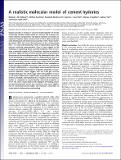A realistic molecular model of cement hydrates
Author(s)
Ulm, Franz-Josef; Yip, Sidney; Shahsavari, Rouzbeh; Kushima, Akihiro; Buehler, Markus J; Van Vliet, Krystyn J; Pellenq, Roland Jm; ... Show more Show less
DownloadPellenq-2009-A realistic molecula.pdf (747.2Kb)
PUBLISHER_POLICY
Publisher Policy
Article is made available in accordance with the publisher's policy and may be subject to US copyright law. Please refer to the publisher's site for terms of use.
Terms of use
Metadata
Show full item recordAbstract
Despite decades of studies of calcium-silicate-hydrate (C-S-H), the structurally complex binder phase of concrete, the interplay between chemical composition and density remains essentially unexplored. Together these characteristics of C-S-H define and modulate the physical and mechanical properties of this “liquid stone” gel phase. With the recent determination of the calcium/silicon (C/S = 1.7) ratio and the density of the C-S-H particle (2.6 g/cm[superscript 3]) by neutron scattering measurements, there is new urgency to the challenge of explaining these essential properties. Here we propose a molecular model of C-S-H based on a bottom-up atomistic simulation approach that considers only the chemical specificity of the system as the overriding constraint. By allowing for short silica chains distributed as monomers, dimers, and pentamers, this C-S-H archetype of a molecular description of interacting CaO, SiO[subscript 2], and H[subscript 2]O units provides not only realistic values of the C/S ratio and the density computed by grand canonical Monte Carlo simulation of water adsorption at 300 K. The model, with a chemical composition of (CaO)[subscript 1.65](SiO[subscript 2])(H[subscript 2]O)[subscript 1.75], also predicts other essential structural features and fundamental physical properties amenable to experimental validation, which suggest that the C-S-H gel structure includes both glass-like short-range order and crystalline features of the mineral tobermorite. Additionally, we probe the mechanical stiffness, strength, and hydrolytic shear response of our molecular model, as compared to experimentally measured properties of C-S-H. The latter results illustrate the prospect of treating cement on equal footing with metals and ceramics in the current application of mechanism-based models and multiscale simulations to study inelastic deformation and cracking.
Date issued
2009-09Department
Massachusetts Institute of Technology. Department of Civil and Environmental Engineering; Massachusetts Institute of Technology. Department of Materials Science and Engineering; Massachusetts Institute of Technology. Department of Nuclear Science and EngineeringJournal
Proceedings of the National Academy of Sciences of the United States of America
Publisher
United States National Academy of Sciences
Citation
Pellenq, Roland J. -M et al. “A realistic molecular model of cement hydrates.” Proceedings of the National Academy of Sciences 106.38 (2009): 16102-16107. © 2009 National Academy of Sciences
Version: Final published version
ISSN
1091-6490
0027-8424